Science Shows Us Just How Frozen Star Wars’ Ice Planet Hoth Must Be

If an AT-AT walker (or something even larger) wanted to walk across a frozen lake, how thick would the ice have to be?
Each winter, one of the most spectacular phenomena that appears over Earth’s continents is when natural freshwater — including lakes, rivers, and even waterfalls — freezes over. But even after extreme cold spells and weeks or even months of below-freezing temperatures, that ice is only a certain, finite thickness. If you put too much weight over too small an area, the ice will give way, and you’ll fall through to the dangerously cold waters below.
Yet even on Hoth, the frozen ice planet where the rebel hideout is located in the Star Wars universe, even the most massive objects have no problem walking over the frozen terrain. The very fact that not even the gargantuan AT-AT walkers fall through the ice can teach us how frozen this ice planet is, with implications for science on Earth and science fiction on any planet we can imagine.
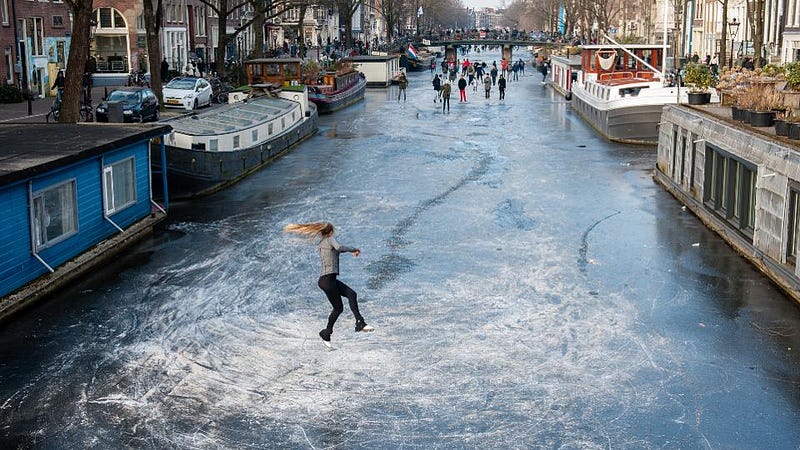
Here on Earth, warnings go out each season to caution hockey players, ice fishers, snowmobilers and even trucks of various weight against bringing too much weight onto ice that’s too thin. This is based on some very straightforward physics that might seem counterintuitive to most, but holds up under the weight of any scientific experiment you care to perform.
If you form a sheet of thin ice, there’s only a certain amount of weight it can hold in any one particular location before the object in question puts too much strain on the ice for it to hold together. Exerting too much force on any material will break it, and the same is true for ice. What surprises people the most, however, is that increasing the thickness of your ice by only a small amount can greatly increase the weight that your ice is capable of bearing.
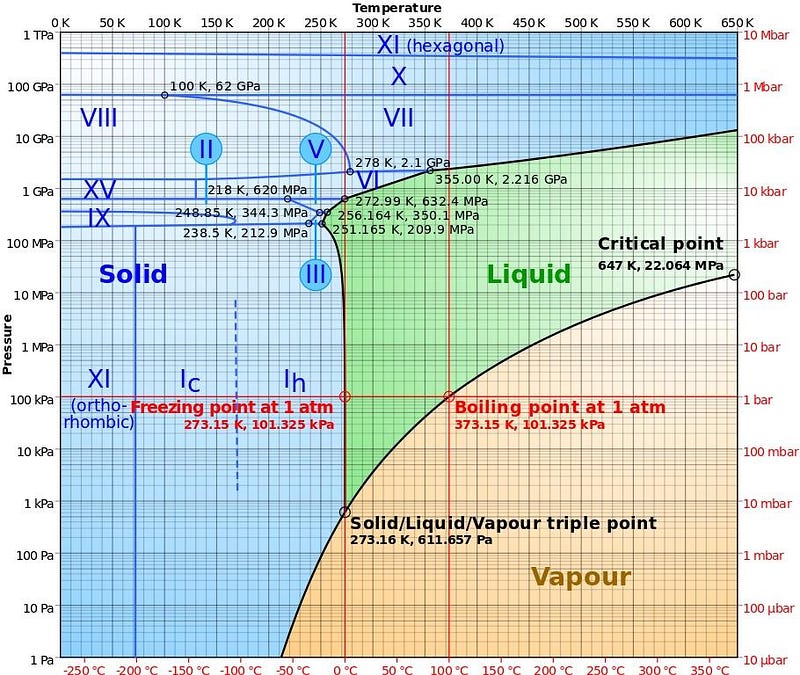
Ice, in general, can take on one of a very large number of forms. Water can bind together in a great number of ways, forming a variety of crystalline structures or even amorphous ones, depending on what temperatures and pressures they’re subject to during their formation.
Under terrestrial conditions (Earth-like temperatures and pressures), however, ice always realistically forms in the same phase: ice Ih, where hexagonal rings of water molecules are bound together in stacked planes of structure, with one oxygen atom (from the H2O in each water molecule) living at each vertex of each hexagon. The fact that the water molecules bind together at the specific angles they do is responsible for the most unusual property of ice: that it’s less dense (and therefore floats atop) than the same substance, water, in its liquid phase.
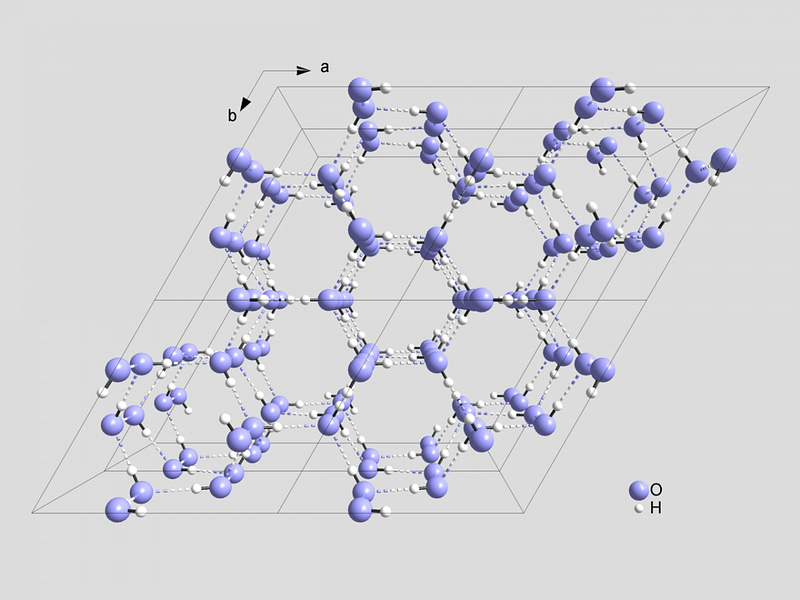
In very thin sheets, this ice has almost no resistance to a perpendicular force; it’s extraordinarily easy to crush your way through ice that’s under an inch (2.5 cm) thick or so. As you build up ice sheets to greater and greater thicknesses, however, the bond strength increases in a particularly interesting fashion: every time you double the thickness of your ice, you quadruple the weight of the load your ice is capable of bearing.
Whereas ice that’s only half an inch (1.25 cm) thick can only withstand approximately 12 pounds of force, enough to questionably support a lightweight cat, by the time your ice reaches 2″ (5 cm) in thickness, a typical full-grown human being could gingerly stand on it, so long as their total weight remained under approximately 200 pounds (about 90 kg in mass).

At about 3″ (7.5 cm), almost any human could safely walk on the ice without being too careful, and at 5″ (12.5 cm), it’s safe to play a game of hockey without a problem. Go up to about 8–10″ (20–25 cm), and you can drive a standard vehicle over it, like a passenger car or a light truck weighing up to approximately 5,000 pounds at the 10″ level.
This trend continues as far as we’ve been able to measure it. At 12″ (30 cm) of ice thickness, even a loaded heavy truck is fine, and at 15″ (38 cm) it’s safe to cross the 10-ton barrier. If you go all the way up to ice that’s 50″ (a little over four feet, or 127 cm) thick, you can safely cross the 100 ton barrier, and that’s where things get interesting for the Star Wars universe.

While the people, animals, and snow speeders that we see on the ice planet Hoth are comparable to the people and vehicles we find on Earth, the advancing AT-AT walkers blow our terrestrial vehicles out of the (frozen) water. These All Terrain Armored Transports (AT-AT walkers) stood at approximately 70 feet (22.5 meters) in height, were plated with heavy, blast-resistant armor, and might even exceed the mass of the largest animal that ever existed on Earth: the blue whale.
At a maximum mass of 173 tons, the blue whale is larger and more massive than any dinosaur that ever roamed the Earth; than any deep sea creature; and much more massive than any heavily armored vehicle or tank to be used on Earth’s surface. Conservatively, a mere 60″ of ice, just 5 feet (or 152 cm) worth, could easily hold it.
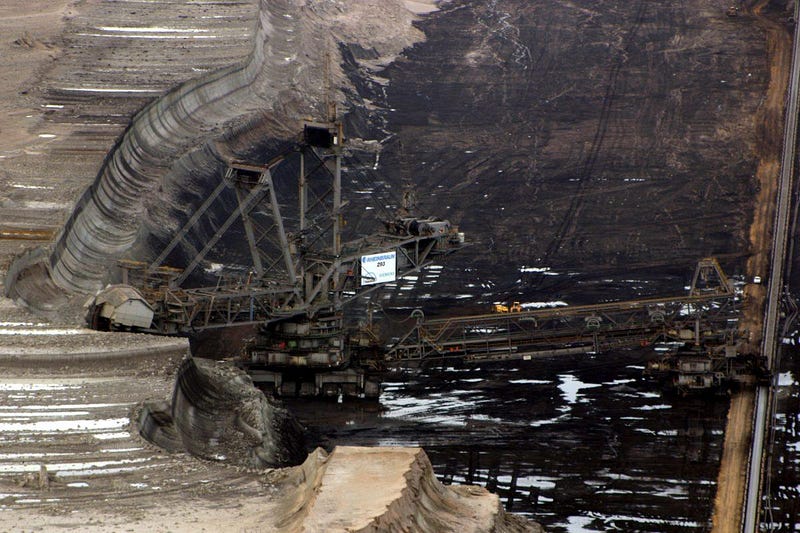
However, we can imagine something even larger if we wanted to by going to extreme scales: the largest land-based vehicle ever build on Earth, the Bagger 293 excavator. At 315 feet (96 meters) tall, 738 feet (225 meters) long, and a mass of 14,200 metric tons (over 31 million pounds of weight), it is the largest and heaviest vehicle ever constructed. Although it’s only used in mining, it can move under its own propulsion via the use of a dozen caterpillar tracks, up to snail-like speeds of 0.4 miles-per-hour (0.6 km/hr).
The only land-based creature or vehicle from any science-fiction franchise that even approaches these masses is Godzilla, who could reach a comparable mass if we assume a body size of approximately 260 feet (80 meters) in height and 525 feet (160 meters) in overall head-to-tail length. At these extreme masses, much thicker ice than needed by even an AT-AT walker is required.
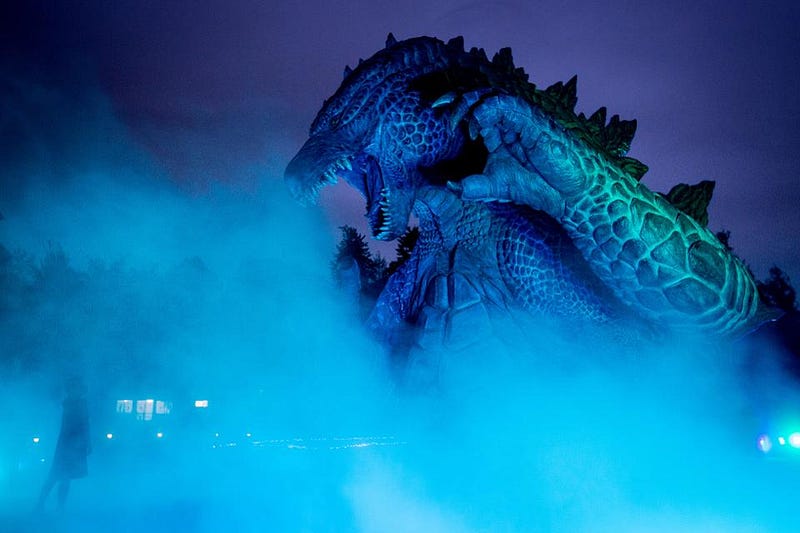
And yet, the same mathematical relationship holds. To hold 100 times the mass of an AT-AT walker, ice that’s merely 10 times as thick will do. If 5 feet (60″, or 152 cm) of ice can support the largest blue whale, then 50 feet (600″, or about 15.2 meters) of ice can support an inordinately enormous Godzilla: one that’s nearly double the height of the Statue of Liberty as measured from sandal-to-torch.
Every year, local, state, and provincial governments warn their residents against treading out on ice that might be too thin, as falling through to the freezing waters below can be lethal, causing victims to go into shock and lose consciousness in less than a minute in some instances. Yet, by sufficiently testing the depth of the ice, you can know whether it’s safe for you to venture out, even if you’re an AT-AT walker pilot. Even, for that matter, if you’re Godzilla.
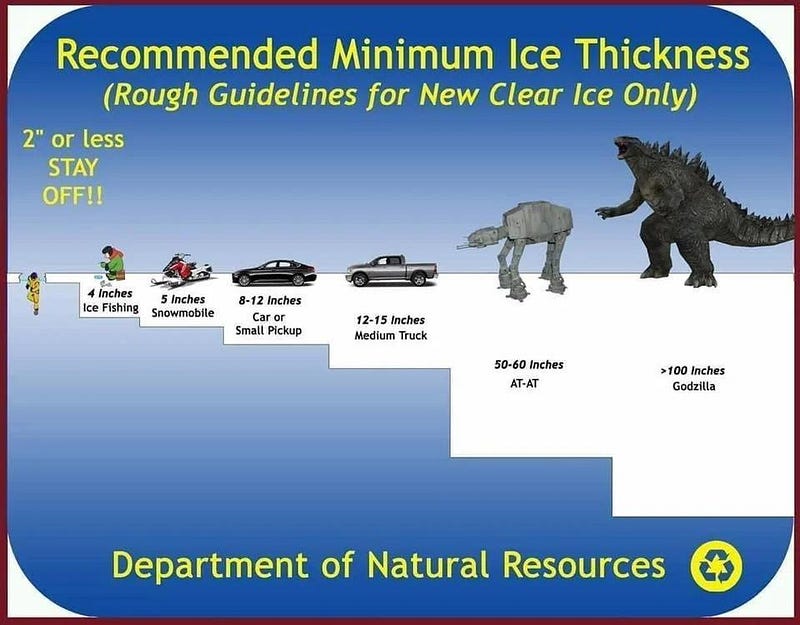
Based on the fact that Hoth appears to exhibit gravity that’s similar to Earth’s, we can assume that its density and size are similar as well, as planetary physics and astronomy indicates. The most massive vehicles we’ve seen walking over its surface tell us surprisingly little about the thickness of the ice there, as even if there’s liquid water beneath it, a mere 5 feet (or 60″, or 152 cm) of ice would be sufficient to hold even at AT-AT walker that falls over onto its side.
But the closest thing we see to a real-life analogue of Hoth — Jupiter’s large, water-rich moon, Europa — has ice that’s so thick it makes every one of these numbers seem like a joke. Whereas even the most extreme example we’ve considered only requires ice that’s approximately 50 feet (15.2 meters) thick to support its weight, Europa’s ice crust is estimated to be approximately 50,000–75,000 feet (15 to 25 kilometers) in thickness.
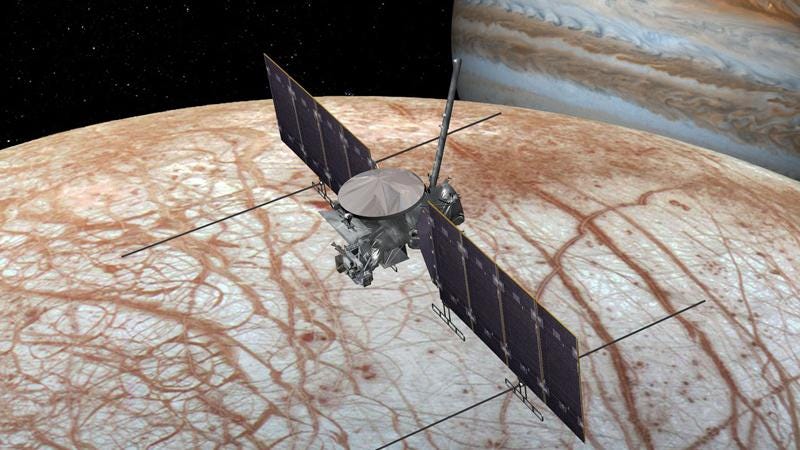
If we wanted to fall through the crust of a realistic ice planet, it would take an object whose mass needed to exceed billions of tons. While this might not be a problem for something like the Death Star, it would realistically take hundreds of Star Destroyers to break all the way through the ice on Hoth to hit the ocean below. The idea that a mundane vehicle could do it, even one as large as the AT-AT walker, just doesn’t match up with what we know about physics.
There’s a reason we have expressions that caution people about treading on thin ice: because it’s the thinness that makes it dangerous, not the ice itself. Every time you double the thickness of your ice, you increase its strength fourfold; every time you increase it by a factor of 10, it can withstand 100 times the mass before giving out. Armed with a little knowledge of physics, everyone who’s properly informed can stay safe this winter: even Godzilla.
Ethan Siegel is the author of Beyond the Galaxy and Treknology. You can pre-order his third book, currently in development: the Encyclopaedia Cosmologica.





